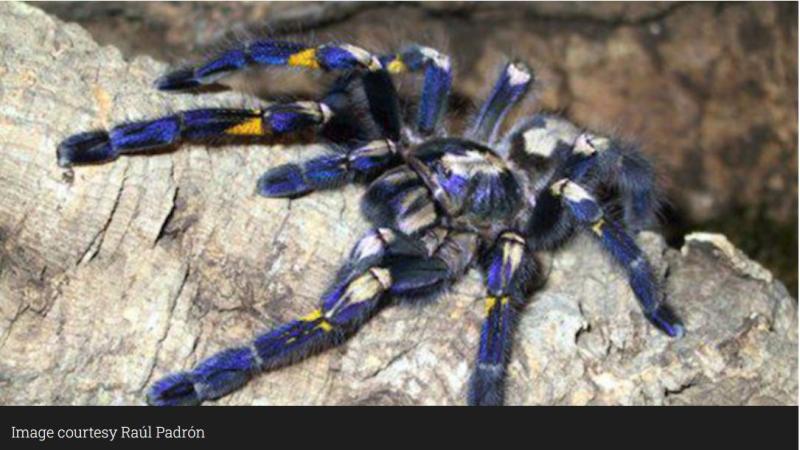Lessons from a Tarantula ( June 13 2017 )
By: HANAE ARMITAGE


Poecilotheria Metallica


Tarantulas—those shaggy arachnids the size of your hand, with bristly bodies and eight bushy legs—harbor a secret. The muscles that control each limb bear a remarkable molecular resemblance to the muscle beating in our chests.
For Christine Seidman , professor of genetics at Harvard Medical School and the HMS Thomas W. Smith Professor of Medicine at Brigham and Women’s Hospital, that likeness did not go unnoticed.
Seidman studies a heart disease called hypertrophic cardiomyopathy, or HCM. In HCM, the heart contracts too well and does not relax properly, which increases energy consumption and leads to adverse events such as arrhythmias and heart failure.
Seidman’s past work has identified eight genes encoding muscle proteins that, if mutated, cause HCM. Most of these mutations are in two genes, one of which codes for myosin, a protein crucial to muscle contraction. These myosin mutations simply switch one amino acid for another.
The findings prompted a new question: How could such a subtle change have such profound effects?
In search of an answer, Seidman looked outside of genetics.
During a Howard Hughes Medical Institute science meeting in 2011, Seidman, who is an HHMI Investigator, sought help from Raúl Padrón, a structural biologist at the Venezuelan Institute for Scientific Research, whose journal articles she’d been following. At the time, Padrón was an HHMI international research scholar studying how muscle proteins interact in tarantulas (which he describes as “very friendly”).
“One of the critical proteins that Raúl was studying was—big surprise—myosin,” said Seidman. Armed with the title of Padrón’s meeting poster, she set out to find him.
Padrón recalls their first interaction in detail. “I was in complete shock when Christine came to my poster; I had never met her before, and she was very well-known in my field, as she discovered many of the mutations we were mapping in the myosin model in our poster,” he said. “She walked up to me and said, ‘We need to work together to understand how different mutations affect the myosin motif.’”
And so they did.

With Padrón’s expertise in structural biology and Seidman’s keen knowledge of genetics, the two investigated how HCM-associated mutations change the structural interactions of myosin that occur during cardiac relaxation.
The two scientists and members of their respective laboratories reported their findings June 13 in the online journal
As a nonstructural biologist, Seidman said, it was beautiful to see the actual myosin structure, even at low resolution.
“And there was another piece that was very important to me,” she said. “Raúl could tell me the amino acids that participate in myosin interactions that occur during relaxation.”
It turned out that many of the amino acids involved in the molecular interactions of relaxation are the very ones that are altered by HCM mutations. That, she said, was “an ‘aha!’ moment.”
Now, the two are planning next steps, asking the natural follow-up questions in their respective fields.
They plan to take advantage of the ongoing “cryo-EM resolution revolution” to achieve near-atomic resolution of myosin interactions by using recently improved cryo-electron microscopy.
“We’d very much like to work with Raúl to solve these structures using human specimens, with and without HCM mutations,” Seidman said. “That would be a big step.”
But the clinician side of Seidman hopes the information will help answer another question.
“We also want to know if there is a way to reduce the symptoms and adverse outcomes that occur in HCM by improving relaxation with small molecules in the heart,” she said. “In addition, we know that abnormal relaxation of the heart occurs in a lot of different diseases, not just HCM, so understanding if these structures might contribute to broader cardiovascular disease will also be very, very important.”
This research was supported by the Leducq Foundation (11-CVD-01); Wellcome Trust (107469/Z/15/Z); Medical Research Council; National Heart, Lung, and Blood Institute of the National Institutes of Health (HL084553); and Howard Hughes Medical Institute.

 Article is LOCKED by moderator [Split Personality]
Article is LOCKED by moderator [Split Personality]



These spiders actually have paws like a cat with 2 or 3 retractable claws per leg.
The Cobalt Blue Tarantula is not venomous but has a mean bite
and can cause a painful scratch.
Delicious.
A very interesting article, SP. Growing up in East Texas Tarantulas were huge and black, and the only thing I really feared at the time, other than snakes. They were venomous and left very nasty bites. I was never bitten by one, but, my older Brother was, and it made him very sick.
I never knew that they had claws until I read this article. Nor the kind of issues that could be learned from them. Very enlightening.
Thank you for sharing this very important information.
We are all ( living things of planet earth )
connected in very mysterious ways.
Having grown up in and returned to the Sonoran Desert in SE Arizona after retiring from the Navy, tarantulas are a very common feature here that us locals respect and leave alone. They are one of the more wonderful creatures of the desert whom if you leave them alone they in turn leave you alone.
Saw too many scorpions in Tubac
Swept a few into a dust bin and threw them down the hill, lol.
My BILs music scared the tarantulas away, lol
That is wicked. It almost does look like a cat paw.
"Almost all spiders are venomous ; only two small families lack venom glands. The purpose of spider venom is to subdue the spider's prey, almost always insects." › biology › spider-myths
DO NOT MESS WITH A COBALT BLUE!
I read one time, don't know if true or not, that the daddy long legs are actually poisonous yet their fangs are too small to puncture us.
Anoon ender..you are correct.. daddy long legs also kill white tailed spiders here that gives a bite and often turns septic..quite a few people have had amputations due to white tail bites. But I guess it does not kill you...
So if I see a daddy long legs it is a friend and not a foe.
What I have seen in my house was I think identified as a wolf spider. A couple of them actually.
That and I had a little jumping spider that hung around the desktop computer. It has been gone for a while so I guess it bit the dust. I kinda liked the little thing.
I have gotten black widows in the garage and places outside.
I had to of the little 'hoppers' in my house when I lived in No Virginia, and they would follow me from room to room as I moved around the house. Then they would repel down on their silk (or whatever it is called) and hang in front of my face, as if trying to get my attention.
When I would be working at the computer one of them would repel down to the desktop and then meander around the keyboard. It was fun to watch them try to inner act with me.
And I had Wolf spiders as well. They looked like a black hairy puffball with legs. (shudder)
The hoppers I didn't mind, but, the Wolf spiders went back outside. I tried putting the hoppers back out, but, they just came back inside and picked up where they left off.
My first fear was the spider was a brown recluse. The wolf spider kinda looks like it.
Then someone told me if it was a brown recluse, you probably wouldn't have seen it. Haha
They're right. You most likely wouldn't have seen it. We have the Brown Recluse spiders here in So Cal. My Brother lived in Imperial Beach and he had one that lived out near the alley in his backyard. He was afraid it would bite his dog so he killed it. They are very poisonous.
Great article.
When I lived in Southern California inland of San Diego we would go out in the evening and watch the tarantulas come out of the desert and cross the roads. They hop not walk or crawl.
When I was a young girl and traveling in Texas, we witnessed the migration of Tarantulas across the highway, which took some time to cross. we had to stop to keep from running over unknown thousands. We could not go around them, as they stretched out for a long way on both sides. We finally had to turn around and stop over night to wait for them to clear the highway so we could finish our trip. Needless to say I had nightmares for months after that.
How beautiful is that.
Cuban tourist guide to tourists;
"No Bay of Pigs tour today, the land crabs have blocked the roads and the Bay is thick with crab caviar"
Would you like to go to Las Tunas and see our absolutely drab Cubano Tarantulas?"
The same thing happens on Christmas Island...an Australian Territory island in the Indian Ocean.. absolutely fascinating..
The showing of the mass crab migration looks very similar to the huge migration of the Tarantulas we saw in Texas, only is was a ocean of black moving across the land and highway. Where they were headed I don't know, but, from what I have also read about their migrations it was quite a long way.
I have to assume that a large number of the crab eggs made it given the size of the massive number of crabs in the migration to the ocean.
I was actually looking for a vid of the same thing on Christmas Island which belongs to Australia.
the same thing happens there annually.
opposite side of the world, 2 different islands.
There is a story about a group of American tourists who were enjoying a guided tour of the jungle near Phuket Thailand in 2013. The highlight of the tour was seeing a beautiful Cobalt Blue tarantula in the wild. One of the tourists, a New Jersey person, poked the huge spider with a stick. When the she turned around the spider hopped on her fat ass and bit her multiple times as she ran away screaming, "GET IT OFF! GET IT OFF!!" The woman's ass swelled up to the size of a hippopotamus butt and she was hospitalized for a month and had to have a colostomy.
My advice is: "DO NOT MESS WITH A COBALT BLUE!"
Very interesting video, al. I have to say that the mouse certainly earned the spiders kiss of death by pestering it one too many times.
I will say the baby is kinda cute.
All I can say is I'm glad to have always been far away from them, at least as well as I know I've been.
Beautiful creatures, the whole lot of them. Scary to look at, but great for the environment. They eat lesser, slow-witted prey.
Great article! Informative to be sure. You must have a minutiae warehouse in that ginormous brain of yours, SP!